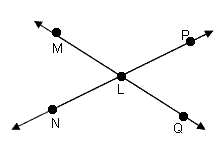Vertical Angles
|
When angles are across from one another in an X pattern, they are called vertical angles. |
In the figure below,
and
are vertical angles. Likewise,
and
are vertical angles.

|
Theorem
|
This means thatand
.
Why is this true? In geometry, we can show that something is true by going through a process called proof. You will learn more about proofs in a later section. Below is a proof for the theorem above.
|
Justification |
 = 180° because they are supplementary. Similarly,
= 180° because they are supplementary. Similarly,  = 180°. Setting the left sides of each equation equal to one another and subtracting the measure of angle MLP, we see that
= 180°. Setting the left sides of each equation equal to one another and subtracting the measure of angle MLP, we see that  . Thus,
. Thus,  . The other pair of vertical angles can be proved congruent by the same method.
. The other pair of vertical angles can be proved congruent by the same method.